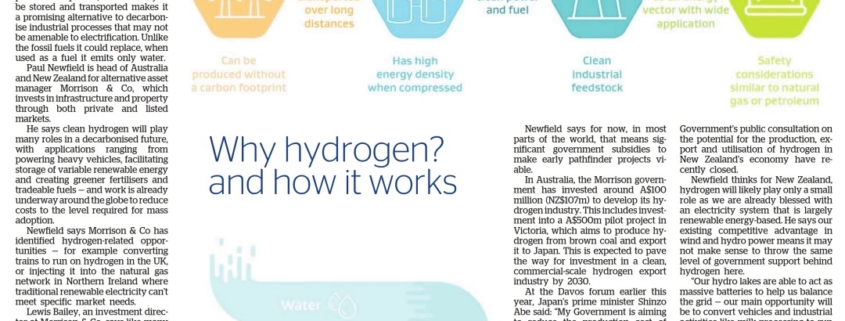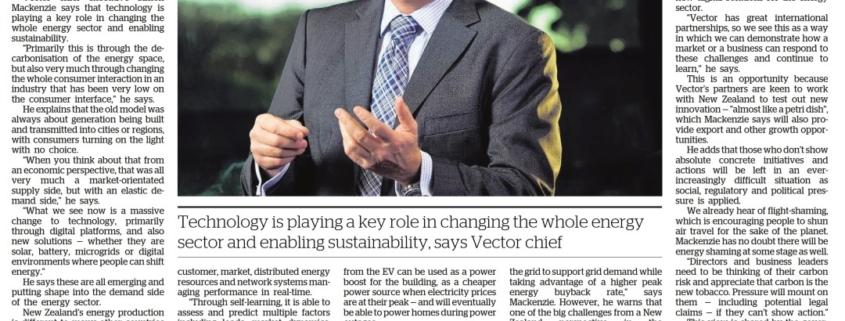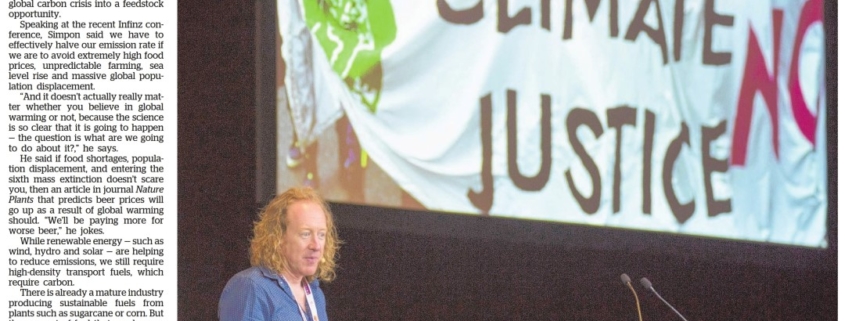http://bit.ly/2C13pb6
Technology is playing a key role in changing the whole energy sector and enabling sustainability, says Vector chief.
Meeting the needs of current generations without compromising the ability of future generations to meet their needs, is about striking the right balance between the environment, society and the economy.
New Zealand’s largest distributor of electricity and gas, Vector, says it is leading the transformation to create a new energy future.
“Meeting the needs of current generations without compromising the ability of future generations to meet their needs, is about striking the right balance between the environment, society and the economy,” it says.
Vector chief executive Simon Mackenzie says that technology is playing a key role in changing the whole energy sector and enabling sustainability.
“Primarily this is through the decarbonisation of the energy space, but also very much through changing the whole consumer interaction in an industry that has been very low on the consumer interface,” he says.
He explains that the old model was always about generation being built and transmitted into cities or regions, with consumers turning on the light with no choice.
“When you think about that from an economic perspective, that was all very much a market-orientated supply side, but with an elastic demand side,” he says.
“What we see now is a massive change to technology, primarily through digital platforms, and also new solutions — whether they are solar, battery, microgrids or digital environments where people can shift energy.”
He says these are all emerging and putting shape into the demand side of the energy sector.
New Zealand’s energy production is different to many other countries in that it uses mainly renewable energy sources including hydropower, geothermal and wind energy. But it is the large fossil fuel generators that are investing massive amounts into emissions-free production to decarbonise their energy production systems.
This is changing the cost curves of these technologies, and is encouraging a shift to a decentralised model. For example, as residents put solar panels on their private property, they are beginning to ask: “I’ve got solar, I’ve got a battery and I’ve got an electric vehicle — how should I use my energy to the best effect?”
And it is here, Mackenzie says, where digital platforms come in — such as Vector’s investment in Internet of Energy (IoE) company mPrest.
He says mPrest’s technology is the most comprehensive monitoring, analytical and control system available anywhere in the world.
“You can think of it as a system of systems. The software sits over customer, market, distributed energy resources and network systems managing performance in real-time.
“Through self-learning, it is able to assess and predict multiple factors including loads, market dynamics, storage, customer demand and capacity. This greatly enhances the resilience, security and efficiency of customer solutions and our network.”
Mackenzie says if you can understand customers’ behaviour and shift them to flatten consumption by 20-30 per cent, then “that’s a massive change in the energy system”.
“Some of these modern electric vehicles (EVs) are turning up in the driveway with in-car battery capacities that are equivalent to seven houses’ worth of demand,” he says.
“This means to charge them quickly, you can have five to seven times the consumption of a house being needed. How do you manage that from an overall efficiency? If you can digitally control when the EV is charged, it is much better than creating new peaks that have to be managed — the costs are significant”.
As an example, EV chargers can help to facilitate energy flow both to and from an EV, allowing it to act as a rechargeable energy source. When connected at home or work, charge from the EV can be used as a power boost for the building, as a cheaper power source when electricity prices are at their peak — and will eventually be able to power homes during power outages.
“Many homes could be powered by their EVs at peak time. Similarly, EVs will be releasing energy back to the grid to support grid demand while taking advantage of a higher peak energy buyback rate,” says Mackenzie. However, he warns that one of the big challenges from a New Zealand perspective in the movement toward sustainability is a risk of complacency.
“We are getting asked questions about our sustainability position and our carbon reporting and we won’t get capital to New Zealand if we are not completely over what the trends are globally and financially.”
He says that just because we are small, at the bottom of the world, and perceived as clean and green, we must not think we are immune from these trends.
“We still have to raise capital from offshore and we need to be able to address questions about our sustainability position and carbon reporting.”
When Vector issued capital bonds, Mackenzie was asked a lot about what Vector is doing in decarbonisation.
“On the capital bond roadshow in New Zealand, some of the brokers were asking the question.
Offshore agencies are also asking about it … it is becoming much more prevalent.”
He says if we are complacent, we will be economically cast adrift.
“We won’t get capital if we aren’t completely over what the trends are globally and financially. But if we act, we can lead the way and create growth opportunities.”
Mackenzie sees this as an opportunity for Vector, because the company can adapt quickly and deploy new technologies.
He has seen rapid advances and focus in this space from global technology players that are developing new digital solutions for the energy sector.
“Vector has great international partnerships, so we see this as a way in which we can demonstrate how a market or a business can respond to these challenges and continue to learn,” he says.
This is an opportunity because Vector’s partners are keen to work with New Zealand to test out new innovation — “almost like a Petri dish”, which Mackenzie says will also provide export and other growth opportunities.
He adds that those who don’t show absolute concrete initiatives and actions will be left in an ever-increasingly difficult situation as social, regulatory and political pressure is applied.
We already hear of flight-shaming, which is encouraging people to shun air travel for the sake of the planet. Mackenzie has no doubt there will be energy shaming at some stage as well.
“Directors and business leaders need to be thinking of their carbon risk and appreciate that carbon is the new tobacco. Pressure will mount on them — including potential legal claims — if they can’t show action.”
This view is shared by the governor of the Bank of England Mark Carney, who earlier this month said companies and industries that are not moving towards zero-carbon emissions will be punished by investors and go bankrupt.
He said it was possible the global transition needed to tackle the climate crisis could result in an abrupt financial collapse, and the longer action to reverse emissions was delayed, the more the risk of a collapse would grow.
But he noted that great fortunes could be made by those working to end greenhouse gas emissions.
Carney told the Guardian that disclosure by companies of the risks posed by climate change to their business was key to a smooth transition to a zero-carbon world as it enabled investors to back winners.
“There will be industries, sectors and firms that do very well during this process because they will be part of the solution,” he said. “But there will also be ones that lag behind and will be punished.”
Sustainable Finance: No such thing as waste (NZ Herald)
http://bit.ly/2N4kMOZ



